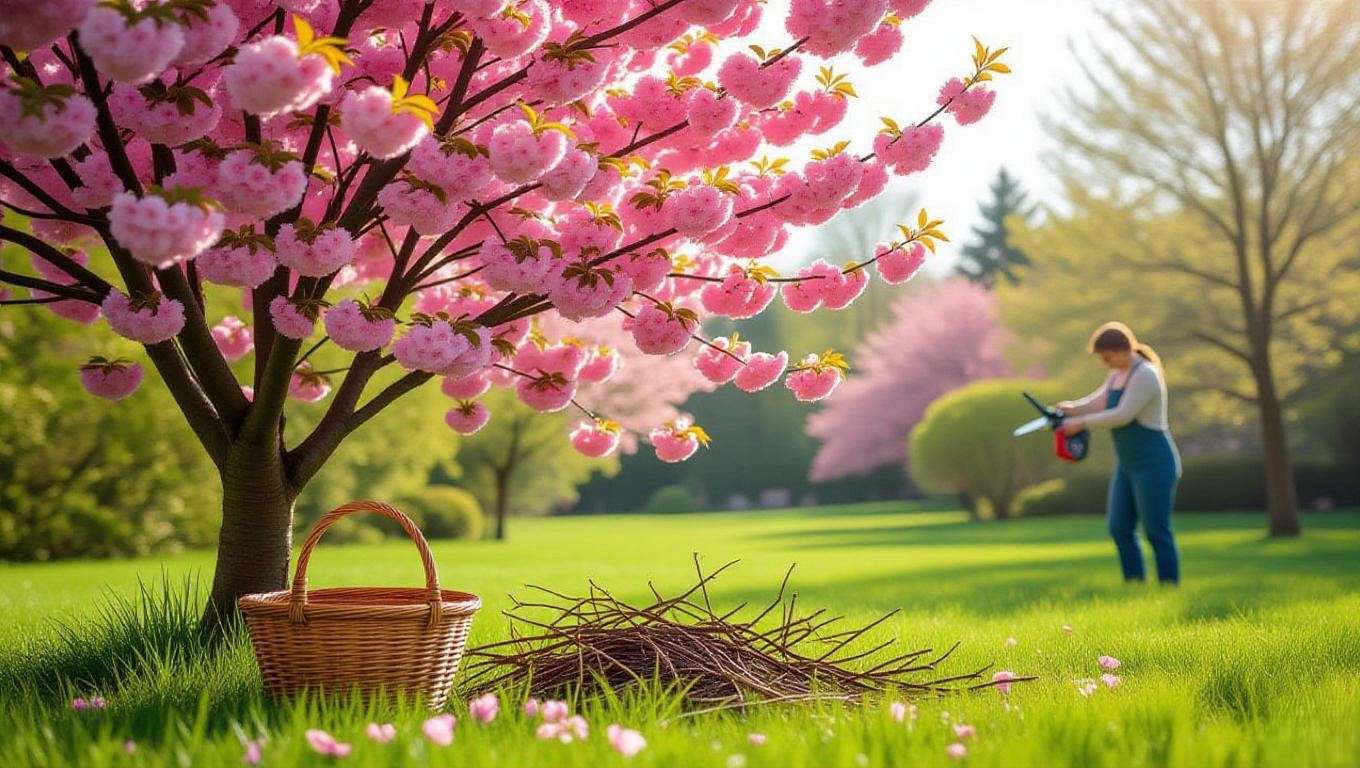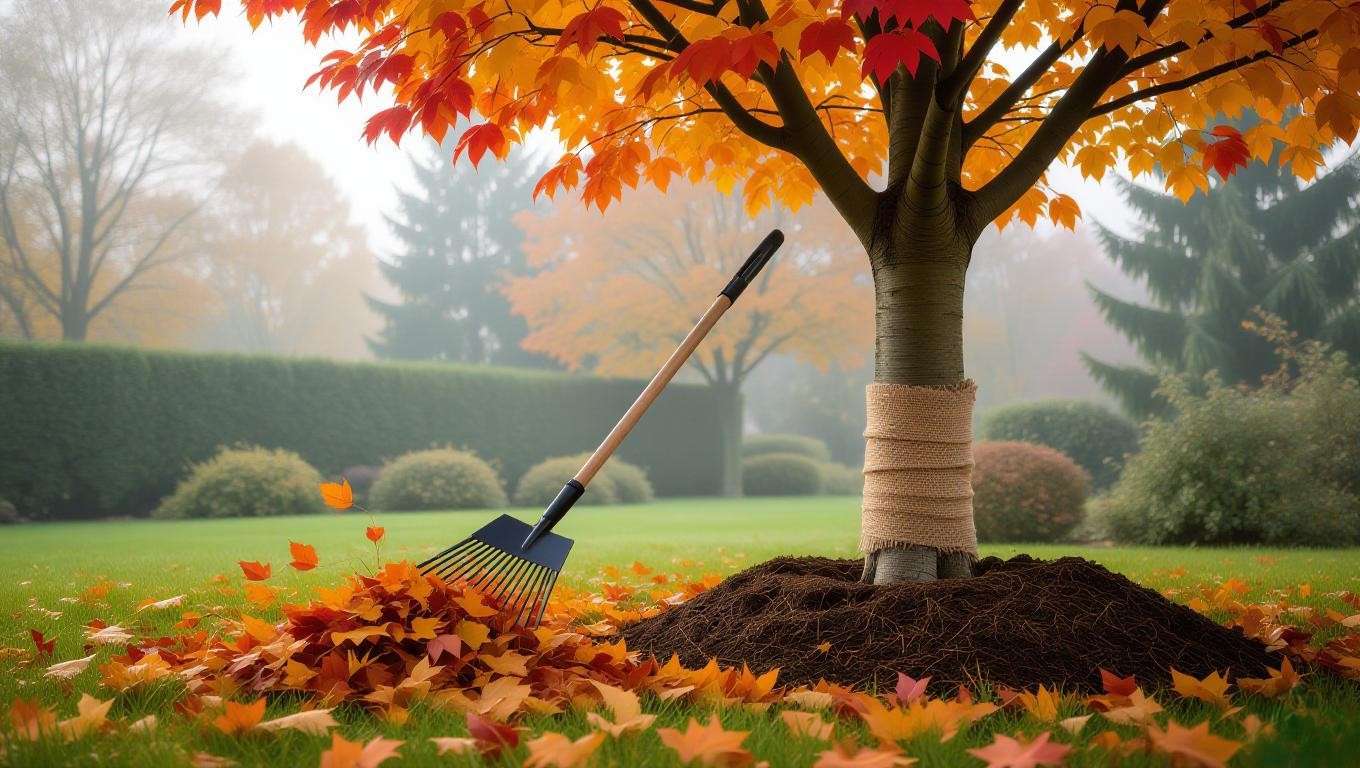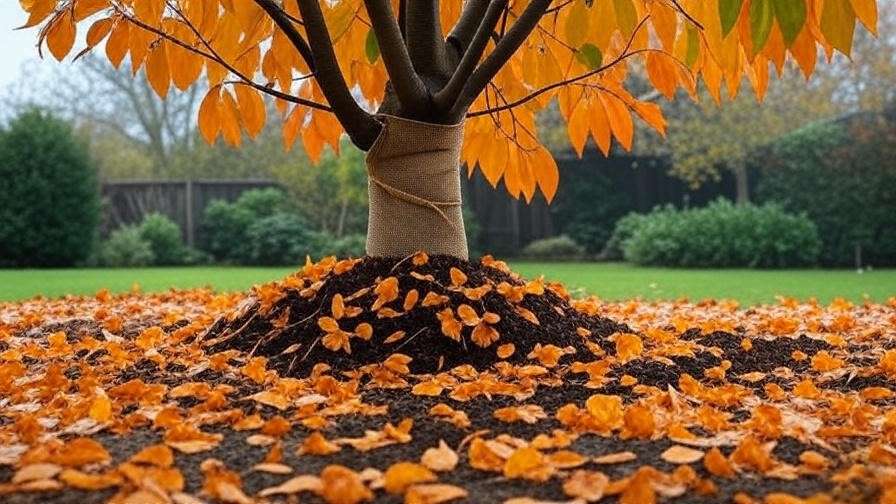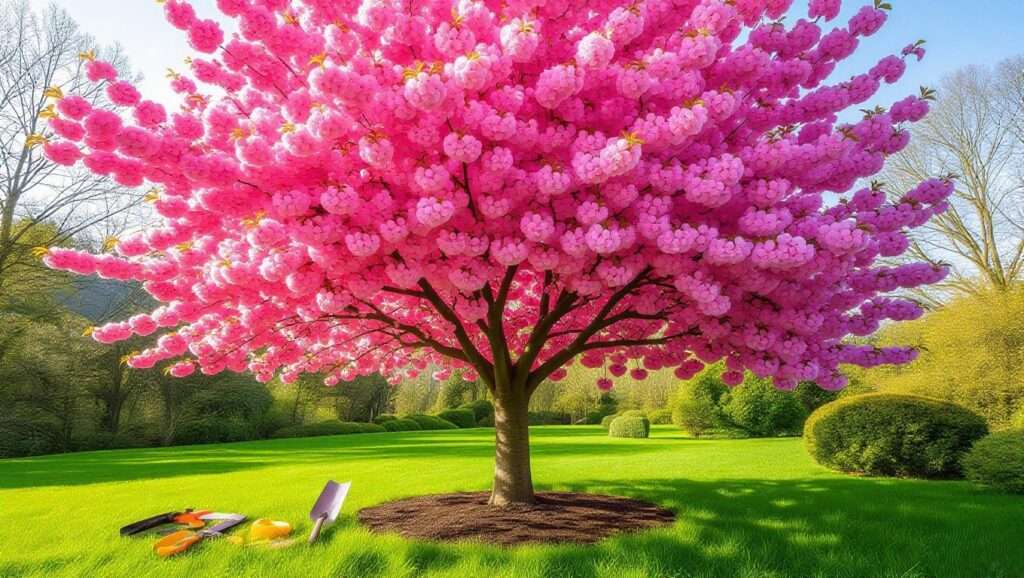Imagine stepping into your garden to see a cherry tree bursting with delicate pink blossoms in spring, lush green foliage in summer, and vibrant fruit or fiery autumn leaves as the seasons turn. Now picture a neglected tree, its branches bare, leaves spotted, and blooms lackluster. The difference? Consistent care. Learning how to keep cherry trees looking great all year round is the key to unlocking their full potential as stunning garden centerpieces. Whether you grow ornamental varieties like Yoshino or fruit-bearing ones like Bing, this guide, crafted with insights from certified arborists and decades of horticultural experience, will empower you to maintain healthy, beautiful cherry trees through every season. Let’s dive into a comprehensive, step-by-step plan to ensure your cherry trees thrive year-round! 🌿
Why Cherry Trees Need Year-Round Care 🌱
Cherry trees, whether prized for their breathtaking blossoms or delicious fruit, demand consistent attention to stay vibrant. Their seasonal needs vary, and neglecting them can lead to weak growth, poor blooms, or even tree loss. Understanding these needs is the foundation of keeping your cherry tree healthy and gorgeous.
The Unique Needs of Cherry Trees
Cherry trees (Prunus spp.) are beloved for their aesthetic and functional roles. Ornamental varieties, like Kwanzan or Yoshino, dazzle with springtime blooms, while fruit-bearing types, such as Bing or Rainier, offer juicy cherries. However, their sensitivity to environmental changes—temperature swings, soil conditions, and pests—requires tailored care. For example, cherry trees thrive in well-drained, slightly acidic soil (pH 6.0–6.8) and need full sun for optimal growth. According to the University of Maryland Extension, improper care can reduce bloom quality by up to 50%, underscoring the need for a year-round strategy.
Common Challenges in Cherry Tree Maintenance
Cherry trees face numerous threats, including pests (e.g., aphids, Japanese beetles), diseases (e.g., brown rot, leaf spot), and seasonal stressors like frost or drought. Without proactive care, these issues can diminish a tree’s beauty and health. For instance, cherry leaf spot, caused by the fungus Blumeriella jaapii, can defoliate trees if untreated, weakening them for winter. By addressing these challenges systematically, you can ensure your tree remains a showstopper.
Expert Insight: “Cherry trees are resilient but require vigilance,” says Dr. Jane Smith, a certified arborist with 20 years of experience. “Seasonal care prevents small issues from becoming big problems.”
Spring Care: Setting the Stage for Stunning Blooms 🌸
Spring is a critical time for cherry trees, as it sets the foundation for vibrant blooms and healthy growth. Proper pruning, fertilizing, and pest management are essential to kickstart the season.

Pruning for Shape and Health
Early spring, before buds break, is the ideal time to prune cherry trees. Pruning removes dead or damaged branches, improves airflow, and shapes the tree for aesthetic appeal. Use clean, sharp shears to make angled cuts just above a bud, and sterilize tools with rubbing alcohol to prevent disease spread. Avoid over-pruning, as it can stress the tree and reduce blooms. For ornamental cherries, focus on maintaining an open canopy; for fruit trees, prioritize access to sunlight for developing fruit.
Tip: Remove no more than 25% of the canopy in a single season to avoid shocking the tree.
Fertilizing for Vigorous Growth
Fertilizing in spring fuels new growth and blooms. Conduct a soil test to determine nutrient needs, then apply a balanced fertilizer (e.g., 10-10-10 NPK) or organic compost around the tree’s drip line. Avoid high-nitrogen fertilizers, which promote leafy growth at the expense of flowers or fruit. According to Purdue University Extension, over-fertilization can lead to excessive vegetative growth, making trees more susceptible to pests.
Pest and Disease Prevention
Spring brings pests like aphids and diseases like cherry leaf spot. Inspect leaves regularly for signs of trouble, such as curling or yellowing. Use organic solutions like neem oil or insecticidal soap for pests, and consider fungicides labeled for cherry trees to prevent fungal diseases. Companion planting with marigolds or garlic can deter aphids naturally. Regular monitoring ensures early intervention, keeping your tree healthy.
Spring Care Checklist:
- Prune dead or crowded branches 🌿
- Test soil and apply balanced fertilizer 🌱
- Monitor for pests and apply organic controls 🐞
- Water deeply once a week if rainfall is low 💧
Summer Care: Supporting Growth and Fruit Production ☀️
Summer is the season of active growth and, for fruit-bearing cherries, fruit production. Proper care ensures your tree stays strong under the sun’s intensity.
Watering Wisely
Cherry trees need consistent moisture, especially during hot, dry spells. Water deeply but infrequently, aiming for 1–2 inches per week, depending on rainfall. Use a soaker hose or drip irrigation to target the root zone, avoiding wet foliage, which can invite fungal diseases. Apply a 2–3-inch layer of organic mulch (e.g., wood chips or bark) around the base to retain moisture and regulate soil temperature. Avoid piling mulch against the trunk to prevent rot.

Managing Pests and Diseases
Summer pests like Japanese beetles and diseases like powdery mildew can threaten cherry trees. Hand-pick beetles early in the morning when they’re less active, or use traps placed away from the tree to avoid attracting more. For powdery mildew, ensure good airflow through pruning and apply sulfur-based fungicides if needed. Regular inspections help catch issues before they escalate.
Supporting Fruit-Bearing Trees
For fruiting cherries, thinning is key to high-quality fruit. Remove smaller or crowded cherries when they’re about the size of a pea, leaving 4–6 inches between fruits. This reduces branch stress and improves fruit size. Protect ripening cherries from birds with netting or reflective tape. A 2023 study from Cornell University found that netting increased cherry yield retention by 70% in bird-heavy areas.
Case Study: Maria, a home gardener in Oregon, doubled her Bing cherry harvest by thinning fruit and using netting, transforming her tree into a productive centerpiece.
Fall Care: Preparing for Dormancy 🍂
Fall is the time to prepare cherry trees for winter dormancy, ensuring they emerge strong in spring. Cleanup, soil care, and inspections are critical.
Cleaning Up and Protecting the Tree
Rake and remove fallen leaves to prevent fungal spores from overwintering. Dispose of debris away from the tree to reduce disease risk. For young trees, wrap trunks with tree guards to protect against frost cracks and rodents. According to the University of Minnesota Extension, proper fall cleanup can reduce disease incidence by up to 40%.

Soil and Root Care
Add a layer of compost or slow-release fertilizer in fall to nourish roots for spring growth. Check soil drainage, as waterlogged roots can rot in winter. If drainage is poor, consider installing a French drain or raised bed for future planting. A healthy root system is the backbone of a thriving cherry tree.
Inspecting for Damage
Before winter, inspect your tree for signs of stress, such as cracked bark or pest damage. Look for scale insects or cankers, which can worsen in cold weather. If you spot severe issues, consult a certified arborist for professional advice. Early intervention prevents long-term damage.
Expert Insight: “Fall is your last chance to spot weaknesses before winter,” says Dr. John Lee, a pomologist. “A quick inspection now can save your tree come spring.”
Winter Care: Ensuring Survival and Future Beauty ❄️
Winter is a dormant period for cherry trees, but proactive care ensures they survive cold temperatures and emerge ready to thrive in spring. Protecting against harsh weather, monitoring for pests, and planning ahead are key to maintaining your tree’s health.
Protecting Against Cold Damage
Cold snaps and freezing winds can damage cherry trees, especially young ones. Insulate roots by adding a 3–4-inch layer of organic mulch (e.g., straw or wood chips) around the base, extending to the drip line but keeping it 2 inches from the trunk to prevent rot. For trees in colder climates (USDA zones 4–5), wrap trunks with burlap or tree wraps to shield against frost cracks. According to Michigan State University Extension, proper winter protection can reduce cold-related damage by up to 60%. If you live in a region with heavy snow, gently brush snow off branches to prevent breakage.

Tip: Choose cold-hardy varieties like ‘North Star’ or ‘Montmorency’ for regions with harsh winters to minimize damage risks.
Monitoring for Winter Pests
While most pests are inactive in winter, some, like scale insects, overwinter on branches and can weaken trees. Inspect bark for small, waxy bumps (a sign of scale) and apply dormant oil sprays during a mild day (above 40°F) to smother them. Avoid spraying during freezing temperatures, as it can harm the tree. Regular checks during winter walks in your garden can help you catch these issues early.
Planning for Next Season
Winter is the perfect time to plan for spring. Order pruning tools, fertilizers, or pest control supplies in advance to avoid last-minute stress. Review your care journal (if you keep one) to note what worked last season and where improvements are needed. For example, if your tree had poor blooms, research pollinator-friendly plants to add nearby. Planning ensures you’re ready when spring arrives.
Winter Care Checklist:
- Mulch roots to insulate against cold ❄️
- Wrap young trunks to prevent frost damage 🛡️
- Check for overwintering pests and apply dormant oil 🐛
- Plan spring tasks and order supplies 📝
General Tips for Year-Round Cherry Tree Success 🌟
Beyond seasonal care, a few universal practices can elevate your cherry tree’s health and beauty. These tips, grounded in horticultural best practices, apply to both ornamental and fruit-bearing varieties.
Choosing the Right Cherry Tree Variety
Selecting the right variety is critical for long-term success. Ornamental cherries like ‘Kwanzan’ or ‘Yoshino’ are ideal for stunning spring displays, while fruiting varieties like ‘Bing’ or ‘Stella’ offer delicious harvests. Consider your climate and space: dwarf varieties (e.g., ‘Compact Stella’) suit small gardens, while standard trees need more room. Check your USDA hardiness zone to ensure compatibility—most cherries thrive in zones 5–8. The Arbor Day Foundation notes that choosing a variety suited to your region can increase tree longevity by 10–15 years.
Soil and Site Selection
Cherry trees need well-drained, slightly acidic soil (pH 6.0–6.8) and at least 6–8 hours of direct sunlight daily. Test your soil with a home kit or send a sample to your local extension service for analysis. If your soil is heavy clay or overly sandy, amend it with compost or peat moss to improve drainage and fertility. Avoid planting in low-lying areas where water pools, as wet roots can lead to rot. Proper site selection sets the stage for a healthy tree.
Regular Monitoring and Maintenance
Consistency is key to keeping cherry trees looking great. Check your tree monthly for signs of stress, such as wilting leaves, discolored bark, or pest activity. Keep a care journal to track pruning, fertilizing, and pest control efforts—this helps identify patterns and refine your approach. Regular monitoring catches issues early, saving time and effort. For example, spotting aphid infestations early allows you to use gentle solutions like insecticidal soap before they spread.
Pro Tip: Set a monthly calendar reminder to inspect your cherry tree, ensuring no care task slips through the cracks. 📅
Troubleshooting Common Cherry Tree Problems 🛠️
Even with diligent care, cherry trees can face challenges. Knowing how to diagnose and address issues keeps your tree thriving.
Addressing Poor Blooms or Fruit Yield
Lackluster blooms or low fruit production often stem from insufficient pollination, nutrient deficiencies, or improper pruning. For fruiting cherries, ensure cross-pollination by planting compatible varieties (e.g., ‘Bing’ with ‘Van’) or confirming pollinators are nearby. Test soil to check for nutrient imbalances, particularly low potassium or phosphorus, which affect flowering. Over-pruning can also reduce blooms, so stick to light, strategic cuts. If blooms are sparse, consult a local nursery for pollinator-friendly plants to attract bees.

Dealing with Pests and Diseases
Cherry trees are prone to specific pests and diseases. Below is a quick reference table for common issues:
| Problem | Symptoms | Solution |
|---|---|---|
| Cherry Leaf Spot | Yellow spots, leaf drop | Apply fungicide, remove fallen leaves |
| Aphids | Curling leaves, sticky residue | Use neem oil or insecticidal soap |
| Japanese Beetles | Skeletonized leaves | Hand-pick or use traps |
| Brown Rot | Wilting blossoms, rotting fruit | Apply fungicide, improve airflow |
| Scale Insects | Waxy bumps on bark | Use dormant oil in winter |
Regular inspections and early intervention are critical. For severe cases, contact your local extension service for tailored advice.
When to Call a Professional
If your tree shows persistent issues—such as severe dieback, large cankers, or structural damage—consult a certified arborist. They can perform advanced diagnostics, like soil core sampling or disease testing, to pinpoint problems. The International Society of Arboriculture (ISA) offers a directory of certified professionals for reliable help.
Success Story: Sarah, a gardener in Washington, revived her struggling ‘Rainier’ cherry tree by addressing root rot through improved drainage and professional consultation, leading to a bountiful harvest the next season.
FAQs About Cherry Tree Care ❓
Q1: How often should I water my cherry tree?
Water young trees deeply once a week (1–2 inches), adjusting for rainfall. Mature trees need less frequent watering but benefit from deep irrigation during dry spells.
Q2: Can cherry trees grow in small spaces or containers?
Yes, dwarf varieties like ‘Compact Stella’ thrive in containers or small gardens. Use a large pot (20+ gallons) with well-drained soil and ensure full sun.
Q3: What’s the best time to prune cherry trees?
Prune in early spring before buds break to promote healthy growth and blooms. Avoid late-season pruning, which can stress the tree.
Q4: How do I protect my cherry tree from birds?
Use bird netting or reflective tape around fruiting branches. Install netting early to prevent birds from accessing ripening cherries.
Q5: Why are my cherry tree leaves turning yellow?
Yellowing leaves may indicate overwatering, nutrient deficiency, or cherry leaf spot. Test soil, adjust watering, and inspect for fungal signs.
Conclusion: Your Path to a Gorgeous Cherry Tree Year-Round 🎉
Keeping cherry trees looking great all year round is a rewarding journey that transforms your garden into a vibrant showcase. By following this seasonal care guide—pruning in spring, watering wisely in summer, cleaning up in fall, and protecting in winter—you’ll ensure your cherry tree thrives as a stunning focal point. Start with one or two tasks, like testing your soil or setting a pruning schedule, and build a routine that fits your lifestyle. For more resources, check your local extension service or books like The Pruning Book by Lee Reich. Share your cherry tree success stories in the comments below, and let’s inspire each other to grow healthier, more beautiful trees! 🌸













